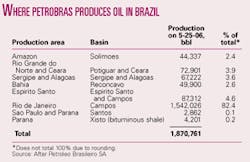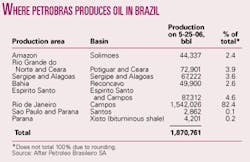Brazil oil output mark may be first of several
Petroleo Brasileiro SA set a daily oil production record May 25 when the company’s output in Brazil was 1.87 million bbl.
Petrobras said the record is “based on the increased recovery of fields located in mature areas in the North and Northeast of the country, as well as the exceptional operating performance of the Campos basin fields.”
The May 25 record was 13,000 b/d more than the previous record set on Dec. 19, 2005, 4.2% higher than the April 2006 average, 6.2% higher than the 2006 daily average, and 11% above the 2005 average.
Campos fields supplied 82.4% of the company’s production on the day of the record, including the P-50 platform that recently started producing at Albacora Leste field. Albacora Leste contributed 75,000 bbl to the daily record.
Another recent contributor is the Capixaba FPSO that serves Golfinho field off Espirito Santo. It accounted for 50,000 b/d, half its handling capacity, after only 20 days in production, Petrobras said (OGJ, May 8, 2006, Newsletter).
The company plans to bring two other floating production facilities on stream in 2006: the P-34 FPSO, 60,000 b/d from Jubarte field off Espirito Santo, and the Sevan Marine SSP-300 monocolumn FPSO, 20,000 b/d in Piranema field off Sergipe.
The Parana basin west of Rio de Janeiro accounted for 4,102 bbl that originated with Petrobras’s oil shale operation. A plant Foster Wheeler Corp. erected in the mid-1950s produces oil from surface-mined bituminous shale, or xisto pirobetuminoso, in the Permian Irati formation.
Providing the oil
Petrobras has a strategic plan that calls for the company’s production to rise to 2.3 million b/d in Brazil and 479,000 b/d internationally by 2010.
The Campos basin’s 1.5 million b/d of oil and 23 million cu m/day of gas comes from 40 fields that belong solely to Petrobras, two fields Petrobras operates in partnership, and three operated by third parties. More than 2,200 wells have been drilled in the fields.
The company said 82% of the oil moves to ship to coastal terminals, and the other 18% of the oil and all of the gas go by pipelines.
The company’s largest onshore producing area is Rio Grande do Norte, which has 45 land and 6 offshore fields in the Potiguar basin.
The fields are concentrated in the Açu Valley and in the state’s western area, including the Alto do Rodrigues, Areia Branca, and Mossoro municipalities, where Canto do Amaro, Brazil’s largest onshore field, is located.
This area has 5,000 onshore wells located on private properties, settlements, and farms.
Potiguar’s offshore production is distributed in the Ubarana, Agulha, Aratum, Pescada, Arabaiana, and Dentao fields.
Petrobras’s 2006-10 regional plan calls for E&D investment of $1.1 billion to develop several fields, including enhancements at Ubarana and Dentao fields. It calls for total drilling of 182 wells in Rio Grande do Norte in 2006. This includes 177 land wells and five offshore, two of which will be in deep water.

